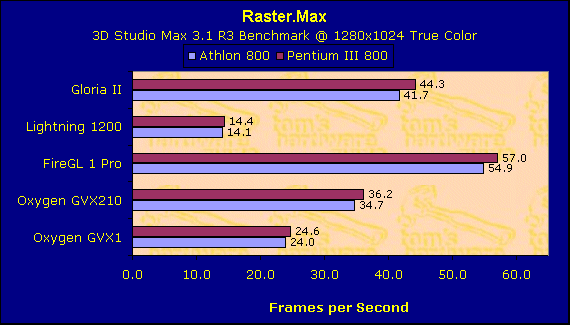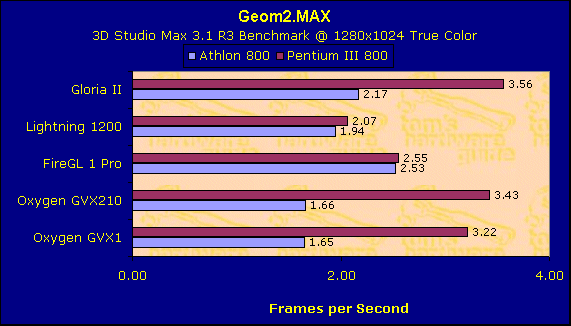Professional Affair: OpenGL Graphics Cards Compete
3D Studio Max 3.1 R3 Benchmark

In this test the camera is constantly moving through the 3D scene. The graphics card must recalculate the scene completely for every frame. In relation to the resolution this extreme rasterization test works with large and small polygons simultaneously.
The clear winner in the rasterization category is the Fire GL 1 from Diamond, achieving an average of 57 frames per second. The Elsa Gloria II with the Quadro chip from Nvidia finishes in second place. All results on the Athlon 800 platform are 5 frames/s below the results on the OR840 with the Pentium III 800. As expected, doubling the fill rate with two GLINT R3 rasterizer chips on the Oxygen GVX210 does lead to twice the performance if compared to the regular fill rate of the GVX1. But at least by implementing the GLINT R3 chips 3DLabs achieves a performance increase of about 45 percent over the smaller brother GVX1.

Geom2.Max uses scenes with up to 200000 polygons. This resembles a good mixture of large connected and unconnected objects. It is an excellent test for the geometry features of the graphics cards. Elsa's Gloria II takes the lead, with the especially programmed MAXTREME plugin boosting the performance of 3D Studio Max. The Nvidia detonator drivers would have strangled the performance of the Gloria II mercilessly, allowing 3DLabs to capture the first and the second place. Nevertheless, we think that the drivers are programmed sloppily. On the Athlon platform the Gloria II, GVX1 and GVX210 achieve only insufficient frame rates. The Fire GL 1 Pro and E & S Lightning 1200 are more balanced. Even though the overall performance is not as good, the performance gap between the Pentium III and the Athlon platform is smaller percentage-wise.
Stay on the Cutting Edge
Join the experts who read Tom's Hardware for the inside track on enthusiast PC tech news — and have for over 25 years. We'll send breaking news and in-depth reviews of CPUs, GPUs, AI, maker hardware and more straight to your inbox.
Current page: 3D Studio Max 3.1 R3 Benchmark
Prev Page Test Procedure Next Page 3D Studio Max 3.1 R3 Benchmark, Continued
